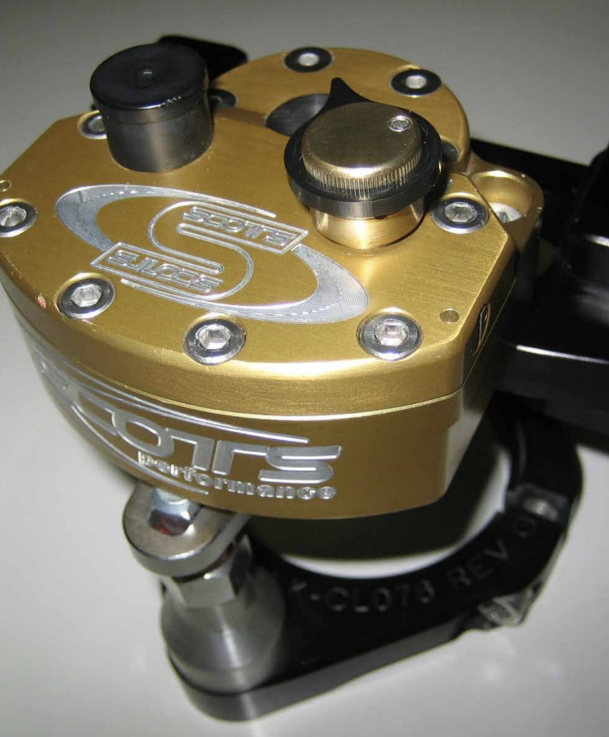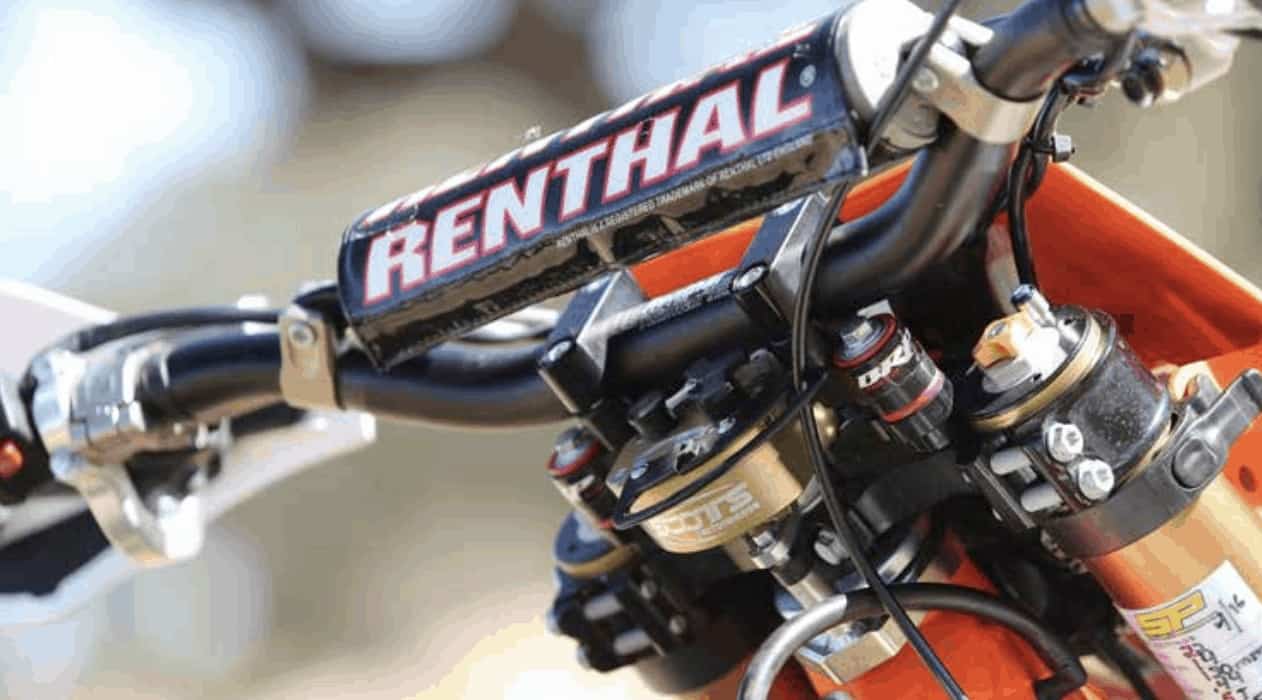RRP: Price for Husky FE350: US $489.95 Contact: www.scottsonline.com
WHAT IS A STEERING STABILIZER (DAMPER)?
The Scotts Steering Stabilizer (Damper) is a hydraulic damper that is fitted to your motorcycle at the centre of the steering head and is attached to the frame by way of a collar and stem which locks into the control arm of the damper. The damper uses a hydraulic oil filled chamber to dampen any sudden sweep of the handlebars away from centre until it reaches the end of the steering sweep where is becomes free as it returns to centre. There is no damping on the return to centre.
The main purpose of the damper is to reduce headshake at speed, especially in off-road bikes and to reduce the effects of a sudden impact and aggressive hits to the front wheel which try and pull the bike out of line.
WHY I CHOOSE SCOTTS PERFORMANCE?
Scotts Performance started in 1987 and has become synonymous with quality and experience. Years of producing high quality hydraulic stabilizers and their ability to consistently maintain very high levels of tolerances have made them the gold standard when choosing a steering damper. I have used them for over two decades and the build quality has always been excellent. These have all been subject to a few heavy crashes, been pelted with roost and rocks, have faced all types of weather conditions and besides a broken knob here or there (the ring around the low-speed adjuster mostly), or some cosmetic wear and tear, they have continued to operate flawlessly.
An annual oil change is recommended but, in most cases, not necessary, or not done by most owners. Longevity is a given and these dampers last.
OPTIONS
Scotts offer two mounting options, either on the bars or SUB mounted (Stabilizer Under Bars) that allows more room for GPS and other accessories.
It also removes the risk of face planting into the on-the-bar option in a crash (that’s something I learnt from personal experience many years ago). An added benefit to tall riders is the SUB mount also raises the bars by between 11-25 mm.

FITMENT AND ADJUSTMENT
Each Scotts damper comes designed specifically for your machine. Depending on the type of damper you’ve chosen there will be a variation to the fitting kit needed to mount the damper to your motorcycle. This means that you can swap the damper from one bike to another without having to purchase a second damper, simply by purchasing a mounting kit for the new bike. Installing the new damper should typically take around 1-2 hours and a top-tip is to have help. Given the need to mount the collar to the frame you will need to remove the triple clamps and without help this can be tricky. If you don’t have anyone to help then we suggest using a tie down to secure the front end and stop it from dropping out of the steering stem when you remove the triple clamps. In the majority of cases the dampers will need little, if any adjustment as delivered.
ADJUSTABILITY AND FUNCTIONALITY
The Scotts dampers offer three separate and isolated highly adjustable tuning features that is unique to Scotts. These allow high speed, low speed and sweep adjustments to be made to the damper to suit rider preference and riding conditions:
- LOW-SPEED DAMPING ADJUSTER: Low speed adjustment can be adjusted on the fly via the left-hand dial on the face of the damper. This controls the tension you feel when turning the bars. The hydraulic fluid acts in a similar fashion to the oil and spring in your forks. When the dial on the low speed damping is backed out all the way (anti-clockwise) you will feel very little resistance at all on the bars, however, even with the high-speed dampening dialled out the bike will feel more stable – even if you can’t feel the effect on the handlebars. As you progressively dial-in the low speed damping (clockwise) the resistance will become more pronounced as your turn the bars away from centre and will free up on full sweep as it returns to centre. Typical low-speed adjustments: for loose sand and mud, a higher setting (clockwise), for tighter woods and turns, less low-speed damping is preferred.
- HIGH-SPEED DAMPING ADJUSTER: This is the right-hand dial on the face under the black cap – it’s a flat screw – unless you purchase the high-speed dial accessory from Scotts to allow on-the-go adjustment. The high-speed circuit absorbs the sharp unexpected hits to the front wheel that try and pull it out of line. The independent highspeed chamber is in my opinion the one of the best features of the Scotts damper. The high-speed adjustments are not measured in clicks and can be pretty sensitive and should be adjusted at 1/8th turn at a time. Not dialling in enough high-speed dampening will lessen one of the best benefits of this damper but you have to be careful to not dial in too much either or it will limit steering response time. Conversely, Scotts warn NOT to adjust the high-speed damping more than three full turns from the full stiff position either. I have added the high-speed dial (accessory) to my damper which replaces the screw-adjust and have found this helpful in keeping the damper dialled-in to my liking and can highly recommend this as part of your purchase, especially if you are a skilled rider.
- SWEEP ADJUSTER AND RETURN TO CENTRE: The sweep adjuster (located on each the side of the damper) adjusts the amount of steering sweep that will be affected by the damper before becoming free. You can control the sweep by making quarter point turns on the adjuster to select where the damper will stop damping and becomes free at the end of the sweep. The ‘nodampening return to centre’ feature is a key component that sets the Scotts apart from its competitors. The settings range from 34 degrees (off-road) to full 90 degrees (on-road). I set my sweep at either the recommended 44º for off-road use or at 34º in certain circumstances but otherwise I leave this adjustment alone. Follow the manual for more details. THE BENEFITS The number of mainly off-road bikes I have ridden over the years with and without a Scotts Steering Stabilizer has made me realise that although the damper will have a greater effect on a bike prone to headshake it does improve overall stability on any bike. The safety net that it provides from those unexpected deflections off roots and rocks has saved my bacon more times than I care to remember. Yes, at around $450 it’s a big investment but, given its longevity, ability to be transferred (for a relatively small cost for the fitting kit) from one bike to another then it could be considered as a primary safety feature for your bike. It also has, I’ve found, other benefits such as saving you from arm pump and lowering fatigue on longer hard-pack rides. And for us over-50s who still like to ‘push it’ a little, even when our strength is waning, I promise that the health preservation features these units provide will grow in value more and more each year.
Warren Malschinger





